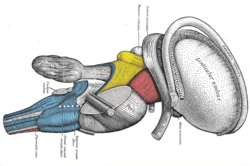Hello and welcome to my blog! Every week of my Senior Research Project I will be posting about the exciting research I am conducting at Barrow Neurological Institute in Phoenix, Arizona.
This week, I will mainly post about vocabulary and key terms of my project, as well as details and tasks I have learned and completed.
Details:
- In my Senior Research Project, I will examine functions of the bed nucleus stria terminalis and pre-optic area through experimentation. As I slice cross sections of the brain and determine area of brain that has a lesion, I will correlate the site and size of the lesion with brain activity function sustained and lost. Ultimately, I hope to determine the effect of lesioning the bed nucleus stria terminalis and pre-optic area on rat behavior.
Vocabulary:
- Thermogradient: Unique to the Systemic Inflammation Laboratory. Proved that rats prefer a neutral ambient temperature. The thermogradient has six tracks; each track holds one rat. A rat is placed on a track, where the side by the heater and hot water bath (see below) is kept at a high temperature, while the other side by the cooling pump and cold water bath is kept at a low temperature. The middle of the track is kept at a thermoneutral temperature.
 |
| Thermogradient Set-up |
Key Terms:
 |
| Stria Terminalis |
- Bed Nucleus Stria Terminalis (BSNT): Found in the limbic system, the stria terminalis is a structure in the brain made out of a band of fibers, which runs along the lateral margin of the ventricular surface of the thalamus until the ventral medial nucleus of the hypothalamus. The stria terminalis is a major output pathway of the amygdala. The activity of the BSNT correlates with anxiety in response to monitoring threats. Interestingly, the central subdivision of the BSNT is sexually dimorphic (meaning the BSNT has apparent differences, which are attributed to gender). It is twice as large in males and has twice as many somatostatin neurons in males than in females. It has been implicated in gender identity disorder, providing a neurological basis.
- Pre-optic Area (POA): Part of the anterior hypothalamus, the POA is responsible for thermoregulation. This area propagates stimuli to the heat-losing and heat-promoting centers of the hypothalamus. The POA contains neurons sensitive to subtle changes in core or hypothalamic temperature.
Tasks:
- Cleaning the thermogradient room: ensuring the rats have a clean and sterile environment to roam
- Counting rat feces left in thermogradient: animals defecate at a higher rate when stressed

Hi Rohini! I read through everything on your blog thus far, and your project seems very interesting and certainly applicable to a place like Arizona where the weather is a bit on the extreme side sometimes. What exactly will you be putting in the cryostat? Cross-sections of the brains you slice?
ReplyDeleteHi Ani! Thanks for reading! So a cryostat is a device where tissues and samples can be mounted and held in place and then manually allows the user to cut slices at set thicknesses. After we perform surgery on the rats and obtain their brains for observation (Yikes!), we place the rat brain in the cryostat and we slice tissues one at a time. It is a very precise process, because the brain and tissue must remain frozen. Next week when I use the cryostat, I will have an article explaining in further detail. Thank you for reading!
ReplyDeleteHey Rohini. This seems like an interesting project to me especially because it's something along the lines of the kind of research I'll be doing over the next three months. Do you have a working hypothesis for your experiment?
ReplyDeleteHi Samdeet! Thanks for reading! As I'm so new to all of this, I don't have a working hypothesis. I'm still getting into the groove of what my project entails, but as I determine a clearer procedure for my experiment, I will have a post about my experiment and my hypothesis.
DeleteYou are off to an excellent start! So exciting to see you using Brain Bee terminology in your first week. I am excited to see what the research reveals regarding thermoregulation as it relates to the different brain centers that control this homeostatic regulatory mechanism.
ReplyDelete